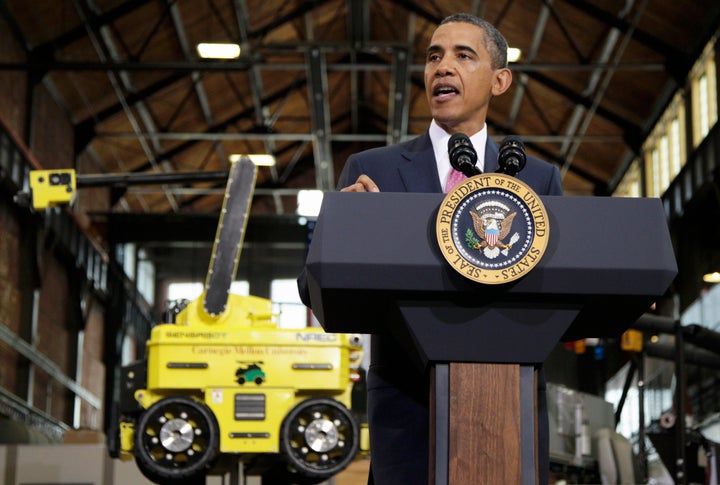
Joking that "one of my responsibilities as commander-in-chief is to keep an eye on robots," President Obama on Friday announced a new public-private sector partnership that will be tasked with driving "a renaissance of American manufacturing."
In a speech at Carnegie Mellon University's National Robotics Engineering Center in Pittsburgh, Pa., Obama laid out plans for the "Advanced Manufacturing Partnership" (AMP) .
According to the president, the group will bring together top engineering universities, beginning with Carnegie Mellon, Stanford, University of California-Berkeley, Georgia Institute of Technology, MIT and the University of Michigan, and leading U.S. manufacturers including Johnson & Johnson, Honeywell, Caterpillar, Northrop Grumman and Corning.
Led by Susan Hockfield, President of MIT, and Andrew Liveris, the CEO of Dow Chemical, a White House press release explained AMP will work across sectors to "create high quality manufacturing jobs and enhance our global competitiveness." The release noted that the partnership will "leverage existing programs and proposals" and invest more than $500 million to jumpstart the effort.
Among the initial investments announced as part of the AMP launch, the government will direct $300 million towards development of high-powered batteries, advanced composites, metal fabrication, bio-manufacturing, and alternative energy. Another $100 million will go towards the "Materials Genome Initiative," which will focus on advanced materials that will speed development in manufacturing, clean energy, and national security.
Making good on the president's promise to monitor those robots, the White House announced the AMP will put $70 million towards research in next generation robotics -- machines that will work in tandem with human operators and provide support across fields ranging from healthcare to manufacturing.
In addition, the Department of Energy has set a goal of leveraging $120 million of its budget to develop innovative manufacturing processes, in a bid to cut the costs of manufacturing while conserving energy.
The president has long been a proponent of an innovation agenda, and he has advocated increasing American investment in green technology and skilled manufacturing since he took office.
"I have a larger vision for America," he said on Friday, "an America where our businesses lead the world in new technologies like clean energy. Where we … invest in what our economy needs to grow: world-class education, cutting-edge research, and building the best transportation and communication infrastructure anywhere in the world. That’s what it’s going to take for us to win the future."
Indeed, the creation of the AMP comes on the heels of several government-supported innovation initiatives. Last week, the Department of Energy announced a $150 million dollar investment in cutting-edge solar power research and development, as part of a pilot innovation investment program known as the Advanced Research Projects Agency - Energy (ARPA-E). Energy Secretary Stephen Chu has called the technology "a game-changer."
While Obama contended that innovations by professors and students at places like Carnegie Mellon had "created more than 300 companies and 9,000 jobs over the past 15 years," some in the manufacturing sector remained skeptical that such high tech investments alone were enough to revitalize the sector.
Scott Paul, Executive Director of the Alliance for American Manufacturing, a coalition of manufacturers and the United Steelworkers union, said in a statement that the AMP showed "promise," but that "the effort will be futile unless our manufacturers also have a solid foundation of support for challenges like unfair trade practices, currency manipulation, developing a skilled workforce, and a more efficient infrastructure."
While the manufacturing sector has shown recent strength -- adding 129,000 jobs this year alone -- the overall number of manufacturing jobs has decreased by 8 million since a peak in 1979 of 19.6 million jobs.
At present, manufacturing accounts for about 11.7 percent of gross domestic product and roughly 9 percent of total employment.
Combating skepticism that any investment in high tech innovation would not create jobs in the near future, Obama was quick to underscore the immediacy of AMP's mandate.
"Let's face it," he said. "As cool as some of this stuff is, as much as we are planning for America’s future, this partnership is about new, cutting-edge ideas to create new jobs, spark new breakthroughs, reinvigorate American manufacturing today. Right now. Not somewhere off in the future -- right now."